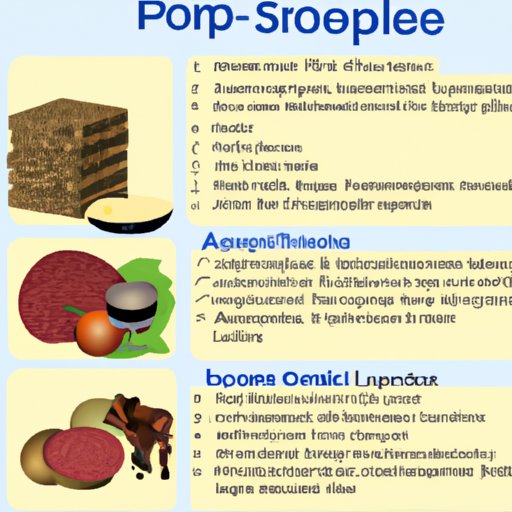Introduction
Scrapple is a classic dish found across the United States. It’s made from pork scraps and trimmings that are mixed with cornmeal and spices. While it’s popular in certain parts of the country, there’s a lot of debate surrounding the healthiness of scrapple. In this article, we’ll take a look at the nutritional content of scrapple, explore the potential health benefits and risks associated with eating it, and consider how it can be incorporated into a balanced diet.

A Nutritional Analysis of Scrapple
Scrapple is made from pork scraps, cornmeal, and a variety of other ingredients, including flour, salt, sage, and black pepper. It’s also high in fat and calories, with a 3-ounce serving containing around 200 calories and 16 grams of fat. It also contains 12 grams of protein and 5 grams of carbohydrates.
The dish is also high in sodium, with one serving containing over 600 milligrams. This is more than 25% of the daily recommended intake for adults, according to the American Heart Association. Scrapple is also low in vitamins and minerals, with only trace amounts of calcium, iron, and vitamin A.

Exploring the Health Benefits of Scrapple
Despite its high fat and sodium content, there are some potential health benefits associated with eating scrapple. For example, the dish is high in protein, which can help to support muscle growth and repair. It also contains a small amount of fiber, which can aid digestion and keep you feeling full for longer.
According to a study published in the journal Nutrition Research, eating a diet rich in protein has been linked to a number of health benefits, including improved blood sugar control, reduced inflammation, and better overall health. The study also found that increasing your dietary intake of protein can help to reduce your risk of developing chronic diseases such as diabetes and heart disease.
Examining the Pros and Cons of Scrapple
When considering whether or not to include scrapple in your diet, it’s important to weigh the pros and cons. On the plus side, the dish is high in protein and can provide a number of health benefits. On the downside, it’s high in fat, sodium, and calories, so it should be consumed in moderation.
In addition, there are some potential risks associated with eating scrapple. For example, the dish is often fried in oil, which can increase the fat and calorie content. Furthermore, the high sodium content can increase your risk of high blood pressure and heart disease. As such, it’s important to pay attention to portion size when consuming scrapple.

Investigating the Ingredients in Scrapple
It’s also important to understand the various ingredients that make up scrapple. The primary ingredient is pork, which is typically made from ground pork, pork trimmings, and pork liver. Other ingredients include cornmeal, flour, salt, sage, and black pepper. Additionally, many brands of scrapple contain preservatives, artificial colors, and other additives.
These ingredients can have an impact on your health. For example, the pork used in scrapple may contain unhealthy fats, and the added preservatives can increase the sodium content. Furthermore, the artificial colors and additives can have unknown health effects. As such, it’s important to read labels carefully when buying scrapple and opt for brands that contain natural, healthy ingredients.
An Overview of Scrapple’s Health Impact
Overall, the impact that scrapple has on your health will depend on the ingredients used and how it’s prepared. When consumed in moderation and prepared using healthy ingredients, scrapple can be a nutritious part of a balanced diet. However, it’s important to remember that it’s high in fat, sodium, and calories, so it should be consumed in moderation.
Understanding the Role of Scrapple in a Balanced Diet
When incorporating scrapple into your diet, it’s important to focus on balance. According to registered dietitian Julie Upton, MS, RD, “Scrapple can be a part of a balanced diet if eaten in moderation and paired with other nutrient-rich foods.” She recommends opting for leaner cuts of pork and avoiding brands that contain lots of preservatives and additives.
It’s also important to note that scrapple should not be the focus of your diet. Instead, it should be just one part of an overall healthy eating plan. Eating a variety of nutrient-rich foods, such as fruits, vegetables, whole grains, and lean proteins, is essential for good health. Additionally, limiting processed foods, added sugars, and saturated fats can help to promote overall wellbeing.
Conclusion
In conclusion, scrapple can be a healthy part of a balanced diet when consumed in moderation and prepared using healthy ingredients. The dish is high in protein and contains a small amount of fiber, which can aid digestion and help to keep you feeling full for longer. However, it’s important to remember that it’s high in fat, sodium, and calories, so it should be eaten in moderation. Additionally, it’s important to opt for brands that contain natural, healthy ingredients, and to focus on eating a variety of nutrient-rich foods as part of an overall healthy eating plan.
(Note: Is this article not meeting your expectations? Do you have knowledge or insights to share? Unlock new opportunities and expand your reach by joining our authors team. Click Registration to join us and share your expertise with our readers.)
